Ariston AS70CX, AS70C User Manual

Instruction booklet
|
|
|
|
|
|
|
|
TUMBLE DRYER |
|
|
|
|
|
|
|
|
|
|
|
|
|
|
|
|
|
|
Contents |
|
|
|
GB |
|
I |
|
F |
|
|
GB |
|
|
|
|
|
|
|
||||
|
|
|
|
|
|
|
Installation, 2 |
|
|
|
English, 1 |
Italiano, 11 |
Français, 21 |
|
|
||||
|
|
|
|
|
|
|
Door reversal instructions |
|
|
|
|
|
|
|
|
|
Where to put your dryer |
|
|
|
D |
|
E |
|
P |
|
|
|
|
|
|
|
|
Ventilation |
|
|
|||
|
|
|
|
|
|
|
Water drain |
|
|
|
Deutsch, 31 |
Español, 41 |
Português, 51 |
|
|
||||
|
Electrical connection |
|
|
||||||
|
|
|
|
|
|
|
Before you start using your dryer |
|
|
|
|
|
|
|
|
|
|
|
|
|
NL |
|
|
|
|
|
Dryer description, 3 |
|
|
|
|
|
|
|
|
|
To open the door |
|
|
|
Nederlands, 61 |
|
|
|
|
|
|
||
|
|
|
|
|
The features |
|
|
||
|
|
|
|
|
|
|
|
|
|
|
|
|
|
|
|
|
Control panel |
|
|
|
|
|
|
|
|
|
Start and programmes, 4 |
|
|
|
|
|
|
|
|
|
Choosing a programme |
|
|
|
AS70C |
|
|
|
|
Laundry, 5-6 |
|
|
|
|
AS70CX |
|
|
|
|
Sorting your laundry |
|
|
|
|
|
|
|
|
|
|
Wash care labels |
|
|
|
|
|
|
|
|
|
Special clothing items |
|
|
|
|
|
|
|
|
|
Drying times |
|
|
Warnings and Suggestions, 7
General safety
Disposal
Saving energy and respecting the environment
Maintenance and Care, 8
Switching off the electricity
Cleaning the filter after each cycle
Empty the water container after each cycle
Check the drum after each cycle
Cleaning the condenser unit
Cleaning the dryer
Troubleshooting, 9
Service, 10
Spare parts
1
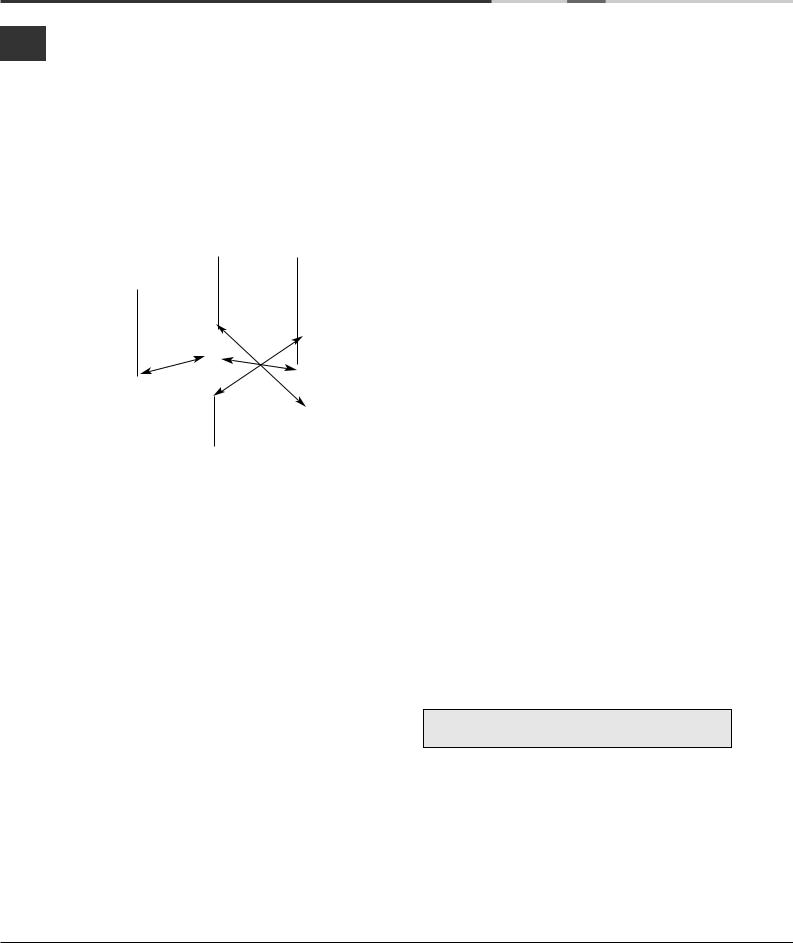
Installation
GB
! Keep this instruction booklet on hand in order to refer to it when necessary. Take it with you when you move, and should you sell this appliance or pass it on to another party, make sure that this booklet is supplied along with the dryer so that the new owner may be informed about warnings and suggestions on how the dryer works.
! Read these instructions carefully; the following pages contain important information on installation and suggestions on how the appliance works.
Door Reversal Instructions
Hinge |
Door catch |
Door latch
Hinge
The door of your dryer is reversible and can easily be changed. Exchange diagonally hinge brackets and blanking screws. Exchange door latch and catch with their opposite blanking plates (see diagram above).
Where to put your dryer
●Place your dryer at a distance from gas ranges, stoves, heaters, or cook tops because flames can damage the appliance.
●If you are going to install the appliance under a work counter, be sure to leave a 10mm space between the top and any other objects on or above the machine and a 15mm space between the sides and lateral furnishings or walls. This is to ensure proper air circulation. Make sure that the back vents are not obstructed.
Ventilation
When the dryer is in use, there has to be adequate ventilation. Make sure you put your dryer in an environment that is not damp and has proper air circulation throughout. Airflow around the dryer is essential to condense the water produced during the washing, the dryer will not operate efficiently in an enclosed space or cupboard.
! If using the dryer in a small or cold room some condensation could be experienced.
Water drain
If your dryer is installed next to a drain the water can be plumbed into this drain. This does away with the need to empty the water container. Simply remove the top hose from its top fitting at the rear of the dryer and plumb the hose provided to the drain.
Electrical connections
Make sure of the following before you insert the plug into the the electrical socket:
●The socket must be grounded.
●The socket must be able to sustain the machines maximum power, which is indicated on the rating label (see Dryer Description).
●Power voltage must be within the values indicated on the rating label (see Dryer Description).
●The socket must be compatible with the dryers plug. Should this not be the case, replace the plug or the socket.
!The dryer must not be installed outdoors, even if the space is sheltered. It can be very dangerous if it is exposed to rain or storms.
!Once installed, the dryers electrical wire and plug must be within easy reach.
!Do not use extension cords.
!The power cord must not be bent or squashed.
!The power cord supplied should be checked periodically and replaced by a cord specially prepared for this dryer and fitted only be authorised technicians (see Service). New or longer power cords are supplied at an extra charge by authorised dealers.
!The manufacturer denies any responsibility should any of these rules not be followed.
!If in doubt about any of the above consult a qualified electrician.
Before you start using your dryer
Once you have installed your dryer and before you use it, clean the inside of the drum to remove any dust that could have accumulated during transport.
2

Dryer Description
To open the door |
The features |
||
Press and release the front |
Water container |
|
Rating plate |
|
|||
panel in position shown |
|
|
|
|
|
|
|
Door
Model & Serial numbers
Door catch
Air intake grille
Condenser cover handle |
Filter |
(Pull to open) |
|
Control panel
HEAT
Button
Drying Guide
The START button  begins drying a selected programme (see Start and Programmes).
begins drying a selected programme (see Start and Programmes).
The HEAT button selects drying temperature (see Start and Programmes).
OUT: HIGH heat  IN: LOW heat
IN: LOW heat 
The Drying Guide allows you to consult a user friendly table of fabric types and load capacities.
 Cottons
Cottons
 Synthetics
Synthetics
 Acrylics and other delicates
Acrylics and other delicates
Empty Water |
Indicator |
|
START |
|
|||
Light |
|
|
Button |
|
|
|
|
|
|
|
|
TIMER
Knob
The Empty Water indicator light  signals that the water container is full and must be emptied. The light will take a few seconds to go out after replacing the empty water container, the dryer must be running for this to happen.
signals that the water container is full and must be emptied. The light will take a few seconds to go out after replacing the empty water container, the dryer must be running for this to happen.
The TIMER knob sets a drying time.
Rotate it clockwise, never counter-clockwise, until the indicator is pointing to the drying time you want to select (see Start and Programmes).
GB
Installation |
|
Description |
|
|
|
|
|
Programmes |
and Start |
|
|
Laundry |
|
|
|
Suggestions |
and Warnings |
|
|
Care |
Maintenance |
|
and |
|
|
Troubleshooting |
|
|
|
Service |
|
|
|
3

Start and Programmes
Choosing a programme
GB
1.Plug the dryer into the electrical socket.
2.Sort your laundry according to fabric type (see Laundry).
3.Open the door make sure the filter is clean and in place and the water container is empty and in place (see Maintenance).
4.Load the machine and make sure items are not in the way of the door seal. Close the door.
5.Choose the drying time by checking the
Drying Guide table for the type of fabric you are drying (see Laundry).
-Set the temperature with the HEAT button.
-Select a drying time by rotating the TIMER knob clockwise.
6.Press the START button to begin.
During the drying programme, you can check on your laundry and take out items that are dry while others continue drying. When you close the door again, press the START button in order to resume drying.
7.About 10 minutes before the programme is completed, it enters the final COOL TUMBLE phase (fabrics are cooled), which should always be allowed to complete.
8.Open the door, take the laundry out, clean the filter and replace it. Empty the water container and replace it (see Maintenance).
9.Unplug the dryer.
4

Laundry
Sorting your laundry
●Check symbols on clothing labels to make sure that the articles can be tumble dried.
●Sort laundry by fabric type.
●Empty pockets and check buttons.
●Close zippers and hooks and tie loose belts and strings.
●Wring out each item in order to eliminate as much excess water as possible.
! Do not load dripping wet clothes into the dryer.
Maximum load size
Do not load more than maximum capacity. These numbers refer to dry weight: Natural fibres: 7kg max (15lb)
Synthetic fibres: 3kg max (6.6lb)
! DO NOT overload the dryer as this could result in reduced drying performance.
Typical load
Clothes
Blouse |
Cotton |
150g |
5oz |
|
Other |
100g |
3oz |
Dress |
Cotton |
500g |
1lb 2oz |
|
Other |
350g |
12oz |
|
|
|
|
Jeans |
|
700g |
1lb 6oz |
|
|
|
|
10 nappies |
|
1000g |
2lb 3oz |
|
|
|
|
Shirt |
Cotton |
300g |
10oz |
|
Other |
200g |
7oz |
T-Shirt |
|
125g |
4oz |
|
|
|
|
|
|
|
|
Household Items |
|
|
|
Duvet cover |
Cotton |
1500g |
3lb 5oz |
(Double) |
Other |
1000g |
2lb3oz |
|
|
|
|
Large Tablecloth |
|
700g |
1lb 6oz |
|
|
|
|
Small Tablecloth |
|
250g |
9oz |
|
|
|
|
Tea Towel |
|
100g |
3oz |
|
|
|
|
Bath Towel |
|
700g |
1lb 6oz |
|
|
|
|
Hand Towel |
|
350g |
12oz |
|
|
|
|
Double Sheet |
|
500g |
1lb 2oz |
|
|
|
|
Single Sheet |
|
350g |
12oz |
|
|
|
|
At the end of a drying cycle, cottons could still be damp if you grouped cottons and synthetics together. If this happens simply give them an additional short period of drying.
Wash Care Labels
Look at the labels on your garments, especially when tumble drying for the first time. The following symbols are the most common:
May be tumble dried
Do not tumble dry
Tumble dry at high heat setting
Tumble dry at low heat setting
Items not suitable for tumble drying
●Articles that containing rubber or rubber-like materials or plastic film (pillows, cushions, or PVC rainwear), any other flammable articles or objects that contain flammable substances (towels soiled with hair spray).
●Glass fibres (certain types of draperies)
●Items which have been dry cleaned
●Items with the ITCL Code  (see Special clothing items). These can be cleaned with special
(see Special clothing items). These can be cleaned with special
at-home dry cleaning products. Follow instructions carefully.
●Large bulky items (quilts, sleeping bags, pillows, cushions, large bedspreads etc). These expand when drying and would prevent airflow through the dryer.
GB
Installation |
|
|
|
Description |
|
|
|
Programmes |
and Start |
Laundry |
|
|
|
Suggestions |
and Warnings |
|
|
Care |
Maintenance |
|
and |
|
|
Troubleshooting |
|
|
|
Service |
|
|
|
5
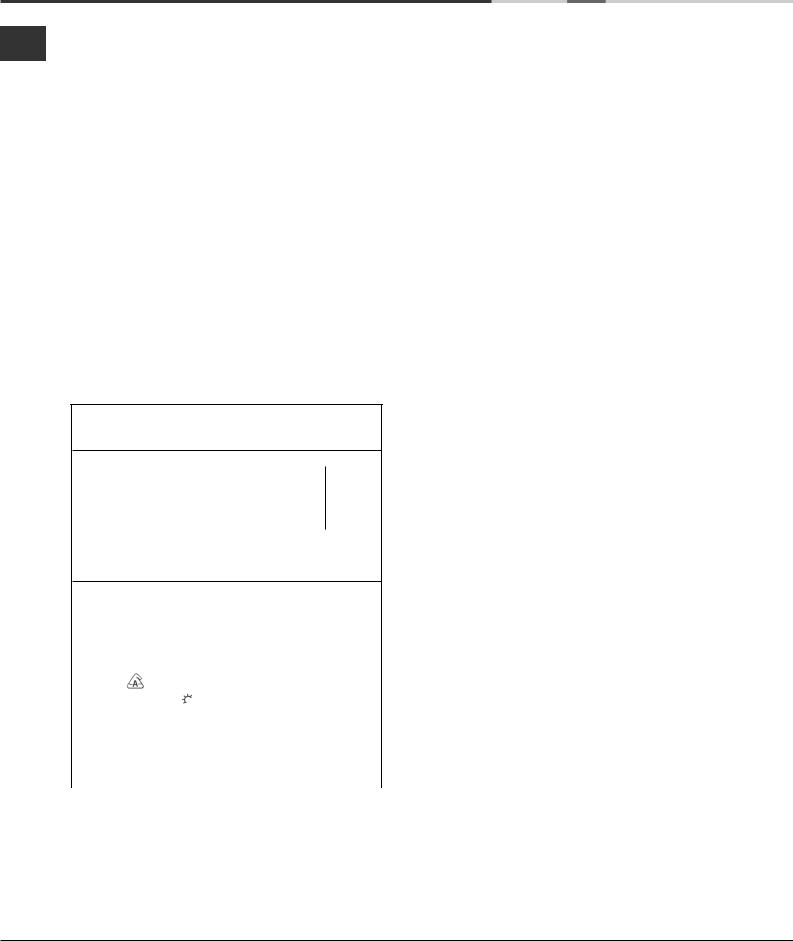
Laundry
Special clothing items
GB
Blankets and Bedspreads: acrylic items (Acilan, Courtelle, Orion, Dralon) must be dried with special care on LOW heat setting. Avoid drying for a long period of time.
Pleated or creased garments: read the manufacturer’s drying instructions on the garment.
Starched articles: do not dry these with non-starched items. Make sure that as much of the starch solution is removed from the load as possible before placing it in the dryer. Do not over-dry: the starch will become powdery and leave your clothing limp, which defeats the purpose of starch.
Drying times
The table below presents APPROXIMATE drying times in minutes. Weights refer to dry garments:
Cottons 
High (full) Heat 
Drying times 800-1000rpm in washing machine
|
|
Half Load |
|
|
|
Full Load |
|
|
|
|
|
|
|
1kg |
2kg |
3kg |
4kg |
5kg |
6kg |
7kg |
|
|
|
|
|
|
|
30-40 |
40-55 |
55-70 |
70-80 |
80-90 |
95-120120-140 |
|
|
|
|
|
|
|
|
Synthetics 
Low (gentle) Heat 
Drying times on reduced spin in washing machine
|
Half Load |
Full Load |
|
|
|
1kg |
2kg |
3kg |
|
|
|
40-50 |
50-70 |
70-90 |
|
|
|
Acrylics |
|
|
Low (gentle) Heat |
|
|
|
|
|
Drying times on reduced spin in washing machine
|
Half Load |
Full Load |
|
|
|
|
1kg |
2kg |
|
|
|
40-60 |
55-75 |
|
|
|
|
Times are approximate and can vary depending upon:
●Amount of water retained in clothes after spin cycle: towels and delicates retain a lot of water.
●Fabrics: items that are the same type of fabric but different textures and thicknesses may not have the same drying time.
●Quantity of laundry: single items or small loads may take longer to dry.
●Dryness: If you are going to iron some of your clothes, they can be taken out while still a bit damp. Others can be left longer if you need them to be completely dry.
●Heat setting.
●Room temperature: if the room where the dryer is located is cold, it will take longer for the dryer to dry your clothes.
●Bulk: some bulky items can be tumble dried with care. We suggest that you remove these items several times, shake them out, and return them to the dryer until finished.
! Do not over-dry your clothes.
All fabrics contain a little natural moisture, which keeps them soft and fluffy.
6
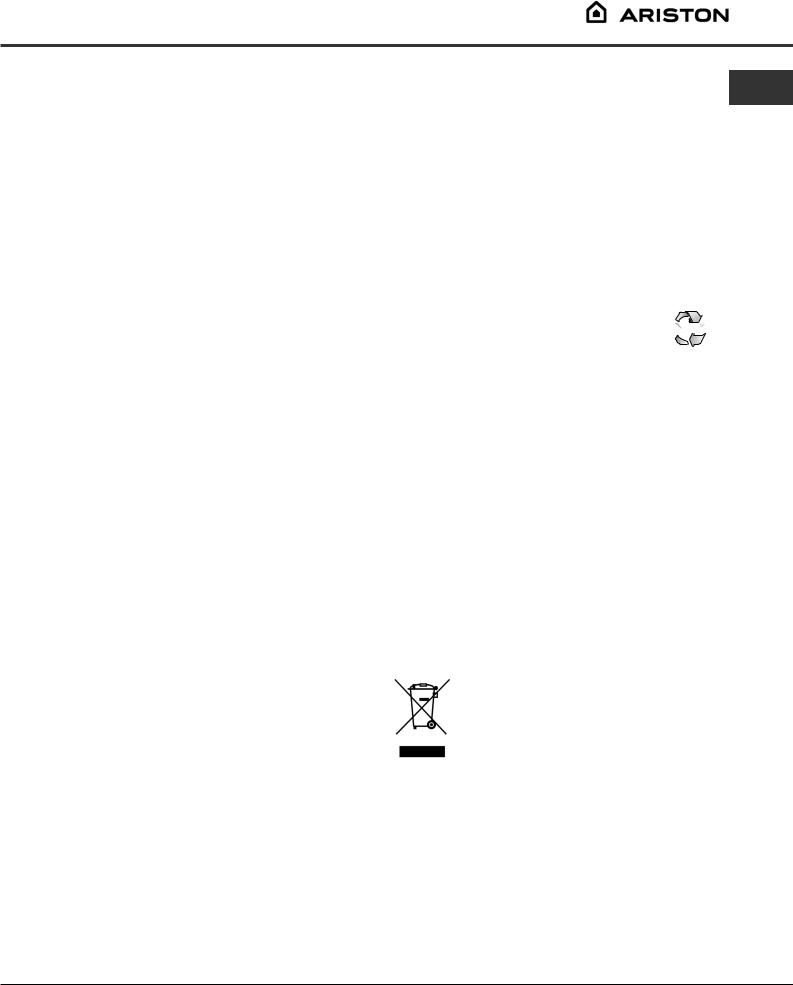
Warnings and Suggestions
! The appliance has been designed and built according to international safety standards. These warnings are given for safety reasons and must be read carefully.
This appliance conforms to the following EEC Directives:
-72/23/EEC and 93/68/EEC (Low Voltage Equipment)
-89/336/EEC, 92/31/EEC and 93/68/EEC (Electromagnetic Compatibility)
General safety
●This tumble dryer has been designed for home, and not professional use.
●This dryer must be used by adults, and the instructions in this booklet should be followed carefully.
●Do not touch the appliance while barefoot or with wet hands or feet.
●Unplug the machine by pulling on the plug, not the cord.
●Children must not be in proximity of the dryer when in use. After using the dryer, turn it off and unplug it. Keep the door closed to make sure that children do not use it as a toy.
●The appliance must be installed correctly and have proper ventilation. The air intake at the front of the dryer and rear vent behind the dryer should never be obstructed (see Installation).
●Never use the dryer on carpeting where the pile height would prevent air from entering the dryer from the base.
●Check to see if the dryer is empty before loading it.
●The back of the dryer could become very hot. Never touch it while in use.
●Do not use the dryer unless the filter, water container and condenser are securely in place (see Maintenance).
●Do not use liquid fabric softeners in the dryer, add it to the final rinse of your wash.
●Do not overload the dryer (see Laundry for maximum loads).
●Do not load items that are dripping wet.
●Tumble dry items only if they have been washed with detergent and water, rinsed and been through the spin cycle. It is a fire hazard to dry items that HAVE NOT been washed with water.
●Carefully check all instructions on clothing labels (see Laundry).
●Do not dry garments that have been treated with chemical products.
●Never dry articles that are contaminated with flammable substances (petrol, oil, paint, hair spray, creams, cooking fat or oils).
●Do not tumble dry rubber, foam rubber, plastic, plastic foam, nappy pants or liners, polythene or paper.
●Do not tumble dry large, very bulky items.
●Do not tumble dry acrylic fibres at high temperatures.
●Complete each programme with its Cool Tumble Phase.
●Do not turn off the dryer when there are still warm items inside.
●Clean the filter after each use (see Maintenance).
●Empty the water container after each use (see Maintenance).
●Clean the condenser unit after regular intervals (see Maintenance).
●Do not allow lint to collect around the dryer.
●Never climb on top of the dryer. It could result in damage.
●Always follow electrical standards and requirements (see Installation).
●Always buy original spare parts and accessories (see Service).
Recycling and disposal information 


As part of our continued commitment to helping the environment, we reserve the right to use quality recycled components to keep down customer costs and minimise material wastage.
●Disposing of the packaging material: follow local regulations, so the packaging can be recycled.
●To minimise risk of injury to children, remove the door and plug - then cut off mains cable, flush with the appliance. Dispose of these parts separately to ensure that the appliance can no longer be plugged into a mains socket.
Disposal of old electrical appliances
The European Directive 2002/96/EC on Waste Electrical and Electronic Equipment (WEEE), requires that old household electrical appliances must not be disposed of in the normal unsorted municipal waste stream. Old appliances must be collected separately in order to optimise the recovery and recycling of the materials they contain and reduce the impact on human health and the environment.
The crossed out “wheeled bin” symbol on the product reminds you of your obligation, that when you dispose of the appliance it must be separately collected.
Consumers should contact their local authority or retailer for information concerning the correct disposal of their old appliance.
Saving energy and respecting the environment
●Wring out items to eliminate excess water before tumble drying (if you use a washing machine first, select a high spin cycle). Doing this will save time and energy during drying.
●Always dry full loads - you save energy: single items or small loads take longer to dry.
●Clean the filter after each use to contain energy consumption costs (see Maintenance).
GB
Installation |
|
|
|
Description |
|
|
|
Programmes |
Startand |
|
|
Laundry |
|
|
|
Suggestions |
Warningsand |
|
|
Care |
Maintenance |
|
and |
|
|
Troubleshooting |
|
|
|
Service |
|
|
|
7

Maintenance and Care
Switching off the electricity
GB
! Unplug your dryer when not using it, when cleaning it and during all maintenance operations.
Clean the filter after each cycle
The filter is an important part of your dryer:
it accumulates lint and fluff that is formed while drying. When finished drying, clean the filter by rinsing it under running water or with your vacuum cleaner. Should the filter become clogged up, the airflow inside the dryer will be seriously compromised: drying times lengthen and you will consume more energy. It may also damage your dryer.
The filter is found in front of the dryer trim (see diagram).
Cleaning the condenser unit
Periodically (every month) remove the condenser unit and clean any build up of fluff from between the plates by rinsing it under the tap with cold water.
This should be done with cold water from the rear of the condenser.
Removing the condenser:
1.Unplug the dryer and open the door.
2.Pull open the condenser cover (see diagram). Release the three catches by turning 90˚ counterclockwise then pull on the grip and remove from the dryer.
3.Clean the surface of the seals and replace, making sure that the catches have been secured.
Removing the filter:
1.Pull the plastic grip of the filter upwards (see diagram).
2.Clean the filter and replace it correctly.
Ensure the filter is fully located flush into the tumble dryer trim.
! Do not use the dryer without replacing the filter.
Empty the water container after each cycle
Pull the container out of the dryer and empty it into a sink or other suitable drain.
Replace the water container securely.
Check the drum after each cycle
Turn the drum manually in order to remove small items (handkerchiefs) that could have been left behind.
Cleaning the dryer
●External parts in metal or plastic and rubber parts can be cleaned with a damp cloth.
●Periodically (every 6 months) vacuum the front air intake grille and vents at the rear of the dryer, to remove any build up of fluff, lint or dust. Also to remove accumulation of fluff from the front of the condenser and filter areas, clean occassionally with a vacuum cleaner.
!Do not use solvents or abrasives.
!Your dryer uses special bearing components which do not need lubrication.
!Have your dryer checked regularly by authorised technicians to ensure electrical and mechanical safety (see Service).
Water container |
Filter |
Tap
Rear
Front
Condenser cover |
Air intake |
Condenser unit
Catches Handle
8
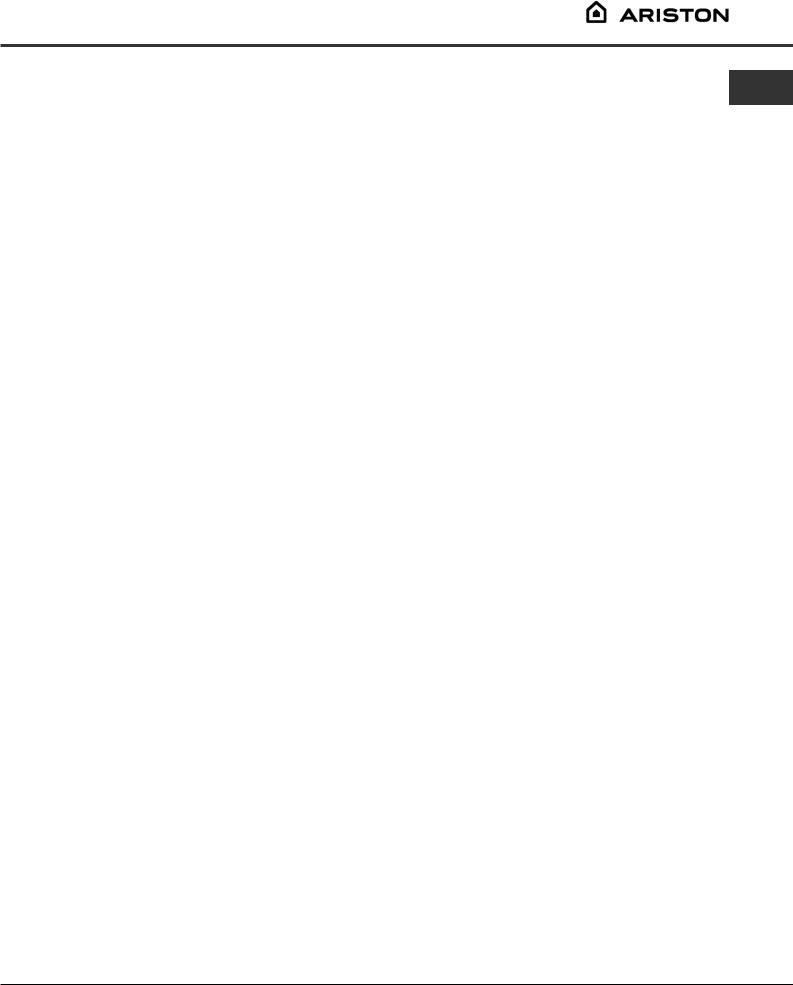
Troubleshooting
One day your dryer seems not to be working. Before you call your Service Centre (see Service), go through the following troubleshooting suggestions:
Problem: |
Possible causes / Solution: |
|
The tumble dryer won’t start. |
● |
The plug is not plugged into the socket, or not making contact. |
|
● |
There has been a power failure. |
|
● |
The fuse has blown. Try to plug another appliance into the socket. |
|
● |
You are using an extension cord? Try to plug the dryer’s power cord |
|
|
directly into the socket. |
|
● |
The door is not closed securely? |
|
● |
The TIMER knob has not been set properly (see Start and Programmes). |
|
● |
The START button has not been pressed (see Start and Programmes). |
Its taking a long time to dry. |
● |
The filter has not been cleaned (see Maintenance). |
|
● |
The temperature setting is not ideal for the type of fabric you are drying |
|
|
(see Start and Programmes, and see Laundry). |
|
● |
The water container needs emptying? The empty water light is on? (see |
|
|
Maintenance). |
|
● |
The condenser needs cleaning? (see Maintenance). |
|
● |
The correct drying time has not been selected for the load (see Laundry). |
|
● |
The air intake grille or rear vents are obstructed (see Installation, and see |
|
|
Maintenance). |
|
● |
The items were too wet (see Laundry). |
|
● |
The dryer was overloaded (see Laundry). |
GB
Installation |
|
|
|
Description |
|
|
|
Programmes |
and Start |
|
|
Laundry |
|
|
|
Suggestions |
and Warnings |
|
|
Care |
Maintenance |
|
and |
|
|
Troubleshooting |
|
|
|
Service |
|
|
|
9

Service
GB
Service
Before calling the Service Centre:
●Use the troubleshooting guide to see if you can solve the problem yourself (see Troubleshooting).
●If not, turn off the dryer and call the Service Centre closest to you.
What to tell the Service Centre:
●name, address and post code.
●telephone number.
●the type of problem.
●the date of purchase.
●the appliance model (Mod.).
●the serial number (S/N).
This information can be found on the data label inside the door of the machine.
Spare Parts
This dryer is a complex machine. Repairing it yourself or having a non-authorised person try to repair it could cause harm to one or more persons, could damage the machine and could invalidate the spare parts warranty.
Call an authorised technician if you experience problems while using the machine.
The spare parts have been designed exclusively for this appliance and not for other uses.
10

Libretto di istruzioni
|
|
|
|
|
|
|
ASCIUGATRICE |
|
|
|
|
|
|
|
|
|
|
|
|
|
|
|
|
|
Indice |
|
|
GB |
|
I |
|
F |
|
I |
|
|
|
|
|
|
||||
|
|
|
|
|
|
|
Installazione, 12 |
|
|
English, 1 |
Italiano, 11 |
Français, 21 |
|
||||
|
|
|
|
|
|
|
Istruzioni per invertire la posizione dello sportello |
|
|
|
|
|
|
|
|
Dove installare l’asciugatrice |
|
|
D |
|
E |
|
P |
|
|
|
|
|
|
|
Aerazione |
|
|||
|
|
|
|
|
|
|
Tubo di scarico dell’acqua |
|
|
Deutsch, 31 |
Español, 41 |
Português, 51 |
|
||||
|
Collegamento elettrico |
|
||||||
|
|
|
|
|
|
|
Informazioni preliminari |
|
|
|
|
|
|
|
|
|
|
|
NL |
|
|
|
|
|
Descrizione del prodotto, 13 |
|
|
|
|
|
|
|
|
Per aprire lo sportello |
|
|
Nederlands, 61 |
|
|
|
|
|
||
|
|
|
|
|
Caratteristiche |
|
||
|
|
|
|
|
|
|
|
|
|
|
|
|
|
|
|
Pannello di controllo |
|
|
|
|
|
|
|
|
Avvio e programmi, 14 |
|
|
|
|
|
|
|
|
Scelta del programma |
|
|
AS70C |
|
|
|
|
Bucato, 15-16 |
|
|
|
AS70CX |
|
|
|
|
Controllo del bucato |
|
|
|
|
|
|
|
|
|
Etichette con le istruzioni per il lavaggio |
|
|
|
|
|
|
|
|
Tessuti particolari |
|
|
|
|
|
|
|
|
Tempi di asciugatura |
|
|
|
|
|
|
|
|
Avvertenze e suggerimenti, 17 |
|
|
|
|
|
|
|
|
Sicurezza |
|
|
|
|
|
|
|
|
Smaltimento |
|
|
|
|
|
|
|
|
Risparmio energetico e rispetto dell’ambiente |
|
|
|
|
|
|
|
|
Cura e manutenzione, 18 |
|
|
|
|
|
|
|
|
Scollegamento dell’apparecchio dalla rete elettrica |
|
|
|
|
|
|
|
|
Pulizia del filtro al termine di ogni ciclo |
|
|
|
|
|
|
|
|
Svuotare il recipiente di raccolta dell’acqua dopo ogni ciclo |
|
|
|
|
|
|
|
|
Controllo del cestello al termine di ogni ciclo |
|
|
|
|
|
|
|
|
Pulizia dell’unità di condensazione |
|
|
|
|
|
|
|
|
Pulizia dell’asciugatrice |
|
|
|
|
|
|
|
|
Ricerca guasti, 19 |
|
|
|
|
|
|
|
|
Assistenza, 20 |
|
|
|
|
|
|
|
|
Ricambi |
|
11
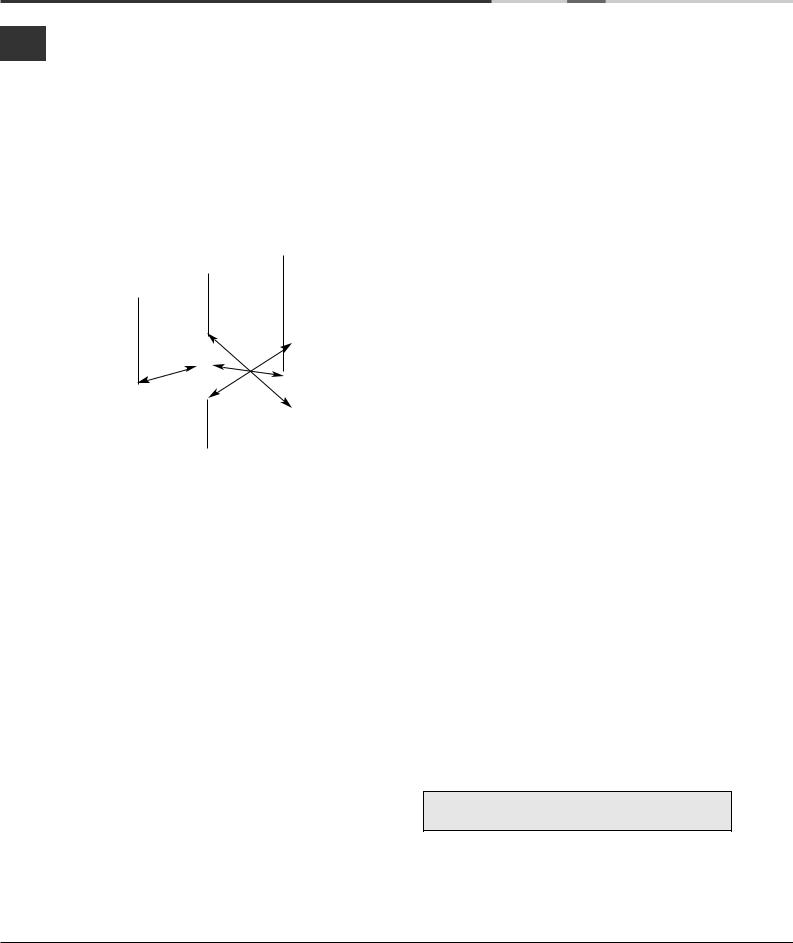
Installazione
I
! Tenere a portata di mano il presente libretto, così da poterlo consultare facilmente ad ogni evenienza. Tenere il libretto sempre vicino all’asciugatrice; nel caso in cui l’apparecchio venga venduto o ceduto ad altre persone, ricordarsi di consegnare loro questo libretto, così da permettere anche ai nuovi possessori di conoscere le avvertenze e i suggerimenti sull’utilizzo dell’asciugatrice.
! Leggere attentamente queste istruzioni: le pagine che seguono contengono importanti informazioni sull’installazione e utili suggerimenti sul funzionamento dell’elettrodomestico.
Istruzioni per invertire la posizione dello sportello
Cerniera
Dispositivo di chiusura sportello
Cerniera
Lo sportello dell’asciugatrice è reversibile ed è facile da cambiare. Spostare diagonalmente le staffe delle cerniere e le viti di chiusura. Invertire il dispositivo di chiusura ed il fermo dello sportello con le piastre di chiusura del lato opposto (vedere lo schema qui sopra).
Dove installare l’asciugatrice
●Le fiamme possono danneggiare l’asciugatrice che deve pertanto essere installata lontano da cucine a gas, stufe, termosifoni o piani di cottura.
●Se l’elettrodomestico verrà installato sotto un banco da lavoro, è necessario lasciare uno spazio vuoto di almeno 10 mm sopra il pannello superiore dell’elettrodomestico; i pannelli laterali dovranno invece avere uno spazio libero intorno di almeno 15 mm. In questo modo sarà garantita la circolazione dell’aria. Controllare che le prese d’aria del pannello posteriore non siano ostruite.
Aerazione
È importante che l’ambiente in cui si utilizza l’asciugatrice sia sufficientemente aerato Assicurarsi inoltre che l’ambiente in cui viene installata l’asciugatrice non sia umido e che vi sia un adeguato ricambio di aria. Garantire un adeguato flusso d’aria intorno all’asciugatrice in modo da permettere che l’acqua prodotta durante il lavaggio si condensi; l’asciugatrice non funzionerà correttamente se posizionata in uno spazio chiuso o all’interno di un mobile.
! Se l’asciugatrice viene utilizzata in una stanza piccola o fredda è possibile che si generi un po’ di condensa.
Tubo di scarico dell’acqua
Se l’asciugatrice viene collocata vicino ad un tubo di scarico, è possibile far defluire l’acqua al suo interno. In questo modo si evita di dover svuotare il recipiente di raccolta dell’acqua. È sufficiente rimuovere il tubo flessibile superiore dalla sua sede sul retro dell’asciugatrice e collegare il flessibile in dotazione al tubo di scarico.
Collegamento elettrico
Prima di inserire la spina nella presa elettrica, verificare che:
●la presa sia dotata di messa a terra
●la presa sia in grado di supportare la potenza massima prevista per l’asciugatrice, così come indicata sull’etichetta che riporta le prestazioni di esercizio (vedere la sezione Descrizione del prodotto)
●la tensione di alimentazione sia compresa nei valori indicati dall’etichetta che riporta le prestazioni di esercizio (vedere la sezione Descrizione del prodotto)
●la presa sia compatibile con il tipo di spina dell’asciugatrice. In caso contrario, sostituire la spina o la presa.
!L’asciugatrice non può essere installata in ambienti all’aperto, anche se riparati. Può essere molto peri coloso esporre questo elettrodomestico alla pioggia o a un temporale.
!Dopo l’installazione dell’elettrodomestico, il cavo e la spina elettrica devono rimanere a portata di mano.
!Non utilizzare prolunghe.
!Il cavo elettrico non deve essere tagliato né
calpes tato.
!Controllare regolarmente il cavo elettrico e, se necessario, farlo sostituire solo da tecnici qualificati che installeranno un altro cavo specifico per questo elettrodomestico (vedere la sezione Assistenza). Presso i rivenditori autorizzati è possibile acquistare cavi di ricambio e cavi più lunghi di quelli montati in fabbrica.
!Il produttore declina ogni responsabilità nei casi in cui le presenti regole non vengano rispettate.
!Se si nutrono dei dubbi a riguardo, consultare un elettricista.
Informazioni preliminari
Una volta installata l’asciugatrice, prima di metterla in funzione, pulire l’interno del cestello, così da rimuovere lo sporco che può essersi accumulato durante il trasporto.
12
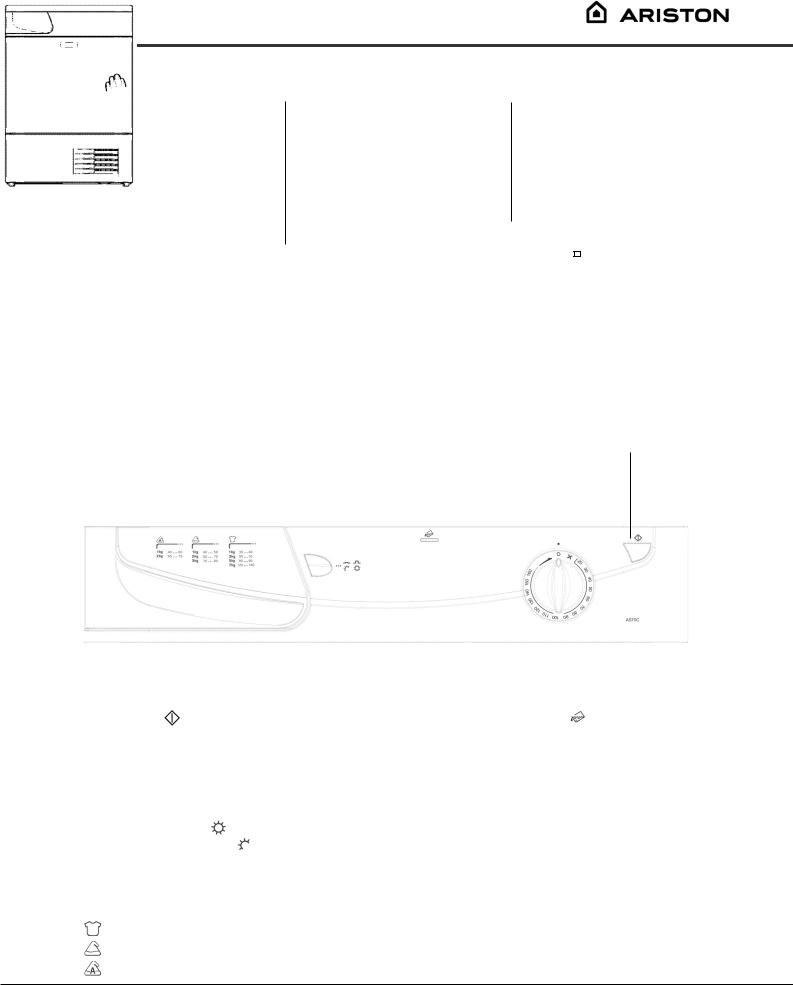
Descrizione del prodotto
Per aprire lo sportello
Premere e rilasciare il pannello frontale nella posizione indicata
Pannello di controllo
Caratteristiche
recipiente di |
|
|
raccolta |
|
Prestazioni di |
|
||
dell’acqua |
|
esercizio |
|
|
|
Dispositivo |
|
|
|
|
|
|
|
|
|
|
|
|
|
di chiusura |
|
|
|
|
|
|
|
|
|
|
|
|
Numero di |
sportello |
|
|
|
|
|
|
|
|
|
|
|
|
|
|
|
|
|
|
|
|
|
|
|
|
|
serie e |
|
|
|
|
|
|
|
|
|
|
|
|
|
|
|
|
|
|
|
|
|
|
|
|
|
|
|
|
numero di |
|
|
|
|
|
|
|
|
|
|
|
|
||
|
|
|
|
|
|
|
|
|
|
|
|
|
modello |
|
|
|
|
|
|
|
|
|
|
|
|
|
Fermo |
|
|
|
|
|
|
|
|
|
|
|
|
|
|
|
|
|
|
|
|
|
|
|
|
|
|
|
dello |
|
|
|
|
|
|
|
|
|
|
|
|
|
|
|
|
|
|
|
|
|
|
|
|
|
|
|
sportello |
|
|
|
|
|
|
|
|
|
|
|
|
||
Coperchio |
|
|
|
|
|
|
|
|
Griglia di entrata |
||||
|
|
|
|
|
|
|
|
||||||
|
|
|
|
|
|
|
|
||||||
|
|
|
|
|
|
|
|
dell’aria |
|||||
|
|
|
|
|
|
||||||||
Maniglia coperchio condensatore |
|
Filtro |
|||||||||||
|
(Tirare per aprire) |
|
|
|
|
|
|
|
|
||||
|
|
|
|
|
|
|
|
|
|||||
pulsante |
Spia luminosa |
Indicatore |
|
pulsante |
|
||||
TEMPERATURA |
svuota acqua |
|
|
START |
|
|
|
|
|
|
|
|
|
|
Guida di asciugatura |
|
|
manopola |
||
|
|
||||
|
|
TIMER |
|||
|
|
|
|
||
|
|
|
|
||
Il pulsante START |
avvia il programma di |
Spia luminoso Svuota acqua |
segnala che il |
||
asciugatura selezionato (vedere la sezione Avvio e |
recipiente di raccolta dell’acqua è pieno e deve |
||||
programmi). |
|
|
essere svuotato. L’indicatore si spegnerà alcuni |
||
|
|
|
secondi dopo aver riposizionato il recipiente vuoto; |
||
Il pulsante TEMPERATURA consente di selezionare |
perché ciò sia possibile l’asciugatrice deve essere in |
||||
la temperatura di asciugatura (vedere la sezione |
funzione. |
|
|||
Avvio e programmi). |
|
|
|
|
|
FUORI: temperatura ALTA. |
La manopola TIMER imposta il tempo di asciugatura: |
||||
DENTRO: temperatura BASSA. |
Ruotare la manopola in senso orario, mai in senso |
||||
|
|
|
antiorario, fino a quando l’indicatore segnala il tempo |
||
La Guida di asciugatura è una tabella di facile |
di asciugatura desiderato (vedere la sezione Avvio e |
||||
comprensione che indica il rapporto tra i tipi di |
programmi). |
|
|||
tessuto e le capacità di carico. |
|
|
|
||
Cotone |
|
|
|
|
|
Sintetici |
|
|
|
|
|
Acrilico e altri delicati |
|
|
|
||
|
I |
Installazione |
|
|
|
Descrizione |
|
|
|
programmi |
e Avvio |
|
|
Bucato |
|
|
|
suggerimenti |
e Avvertenze |
|
|
manutenzione |
e Cura |
|
|
guasti Ricerca |
|
|
|
Assistenza |
|
|
|
13

Avvio e programmi
Scelta del programma
I
1.Inserire la spina dell’asciugatrice nella presa di alimentazione elettrica.
2.Selezionare il bucato in base al tipo di tessuto (vedere la sezione Bucato).
3.Premere lo sportello per aprirlo e controllare la corretta posizione e la pulizia del filtro ed accertarsi che il recipiente di raccolta dell’acqua sia vuoto e posizionato correttamente (vedere la sezione Manutenzione).
4.Caricare l’elettrodomestico, facendo attenzione ad evitare che qualche indumento possa frapporsi tra lo sportello e la relativa guarnizione. Chiudere lo sportello.
5.Scegliere il temp di asciugatura controllando le indicazioni date per il tipo di tessuti che dovete asciugare nella relativa Guida di asciugatura (vedere la sezione Bucato).
-Impostare la temperatura mediante il pulsante TEMPERATURA.
-Selezionare il tempo di asciugatura, ruotando in senso orario la manopola TIMER.
6.Premere il pulsante START per avviare il programma.
Durante il funzionamento, è possibile aprire lo sportello per estrarre i capi che nel frattempo si sono asciugati e lasciare asciugare gli altri. Dopo aver richiuso lo sportello, è necessario ripremere il pulsante START, per mettere nuovamente in funzione l’asciugatrice.
7.Circa 10 minuti prima della fine del programma, viene attivata la fase di asciugatura finale ad aria fredda, che consente di raffreddare i tessuti: si consiglia di non estrarre il bucato prima del completamento di questa fase.
8.Aprire lo sportello, estrarre il bucato, pulire il filtro e metterlo nuovamente in posizione. Svuotare il recipiente di raccolta dell’acqua e rimetterlo al suo posto (vedere la sezione Manutenzione).
9.Scollegare l’asciugatrice dalla rete elettrica.
14
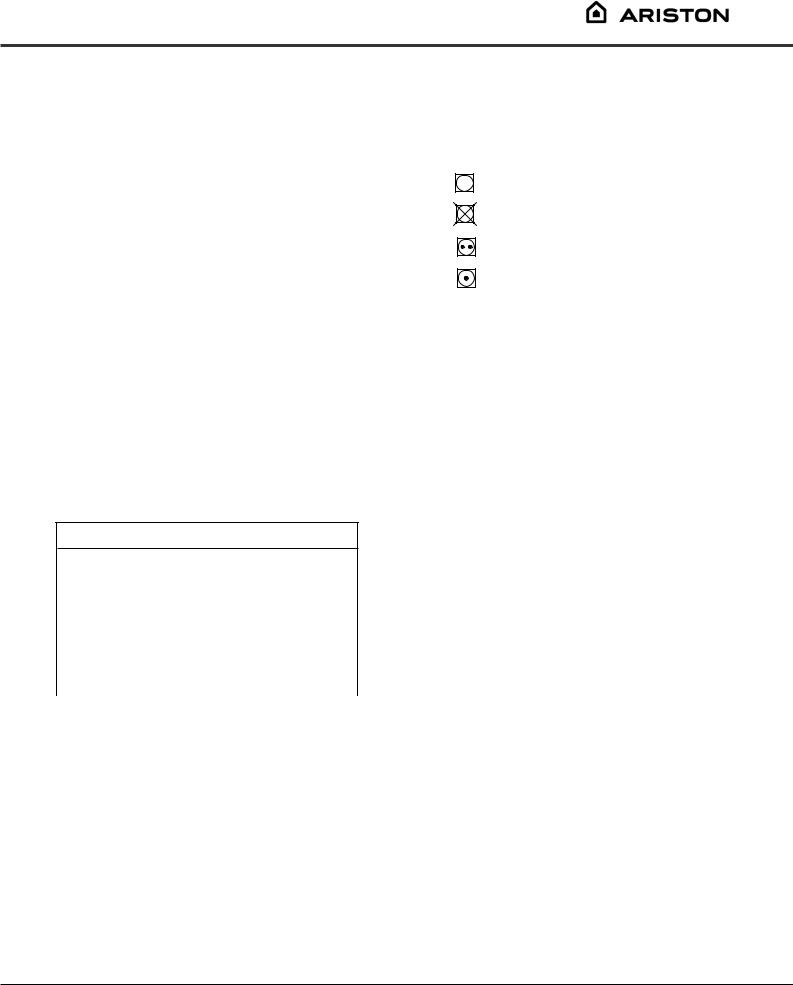
Bucato
Controllo del bucato
●Controllare i simboli riportati sulle etichette dei vari capi, per verificare se l’indumento può essere introdotto nell’asciugatrice.
●Distinguere il bucato in base al tipo di tessuto.
●Svuotare la tasche e controllare i bottoni.
●Chiudere le lampo e i ganci e allacciare senza stringere cinture e lacci.
●Strizzare gli indumenti per eliminare la maggior quantità di acqua possibile.
! Non caricare l’asciugatrice con capi totalmente pieni d’acqua.
Dimensioni massimi di carico
Non caricare il cestello oltre la capacità massima. I seguenti valori si riferiscono al peso degli indumenti asciutti:
Fibre naturali: massimo 7 kg Fibre sintetiche: massimo 3 kg
! NON sovraccaricare l’asciugatrice perché ciò ridurrà l’efficienza dell’elettrodomestico.
Carico tipo
Indumenti
Camicetta |
Cotone |
150 g |
|
|
Altro |
100 g |
|
Abito |
Cotone |
500 g |
|
|
Altro |
350 g |
|
Jeans |
|
700 g |
|
|
|
|
|
10 pannolini |
|
1000 g |
|
Camicia |
Cotone |
300 g |
|
|
Altro |
200 g |
|
T-Shirt |
|
125 g |
|
|
|
|
|
|
|
|
|
Biancheria da casa |
|
|
|
Coperta |
Cotone |
1500 g |
|
(Matrimoniale) |
Altro |
1000 g |
|
|
|
|
|
Tovaglia grande |
|
700 g |
|
Tovaglia piccola |
|
250 g |
|
Straccio da cucina |
100 g |
||
Telo da bagno |
|
700 g |
|
Asciugamano |
|
350 g |
|
Lenzuolo matrimoniale |
500 g |
||
Lenzuolo singolo |
|
350 g |
|
|
|
|
|
Se si mischiano i capi in tessuto sintetico con capi in cotone, questi ultimi potrebbero risultare ancora bagnati al termine del ciclo di asciugatura. In questo caso, avviare un ulteriore breve ciclo di asciugatura.
Etichette con le istruzioni per il lavaggio
Controllare con attenzione le etichette degli indumenti, specialmente se si tratta della prima volta che si introduce il capo in un’asciugatrice. Di seguito sono riportati i simboli più comuni:
Può essere inserito nell’asciugatrice
Non inserire nell’asciugatrice
Asciugare ad alta temperatura
Asciugare a bassa temperatura
Indumenti non adatti al trattamento di asciugatura
●Capi che contengono parti in gomma o materiali simili, membrane di plastica (cuscini, imbottiture o impermeabili in PVC) e ogni tipo di tessuto infiammabile o che contenga sostanze infiammabili (asciugamani sporche di lacca).
●Fibre di vetro (alcuni tipi di tendaggi)
●Indumenti completamente asciutti
●Tessuti contrassegnati con il simbolo  (vedere la sezione Tessuti particolari), che
(vedere la sezione Tessuti particolari), che
possono essere puliti con prodotti speciali di pulizia domestica. Seguire attentamente le istruzioni.
●Elementi troppo voluminosi (piumoni, sacchi a pelo, cuscini, imbottiture, copriletto e così via), che si espandono durante l’asciugatura ed impediscono così all’aria di circolare nell’asciugatrice.
|
I |
|
|
Installazione |
|
|
|
Descrizione |
|
|
|
programmi |
e Avvio |
Bucato |
|
|
|
suggerimenti |
e Avvertenze |
|
|
manutenzione |
e Cura |
|
|
guasti Ricerca |
|
|
|
Assistenza |
|
|
|
15
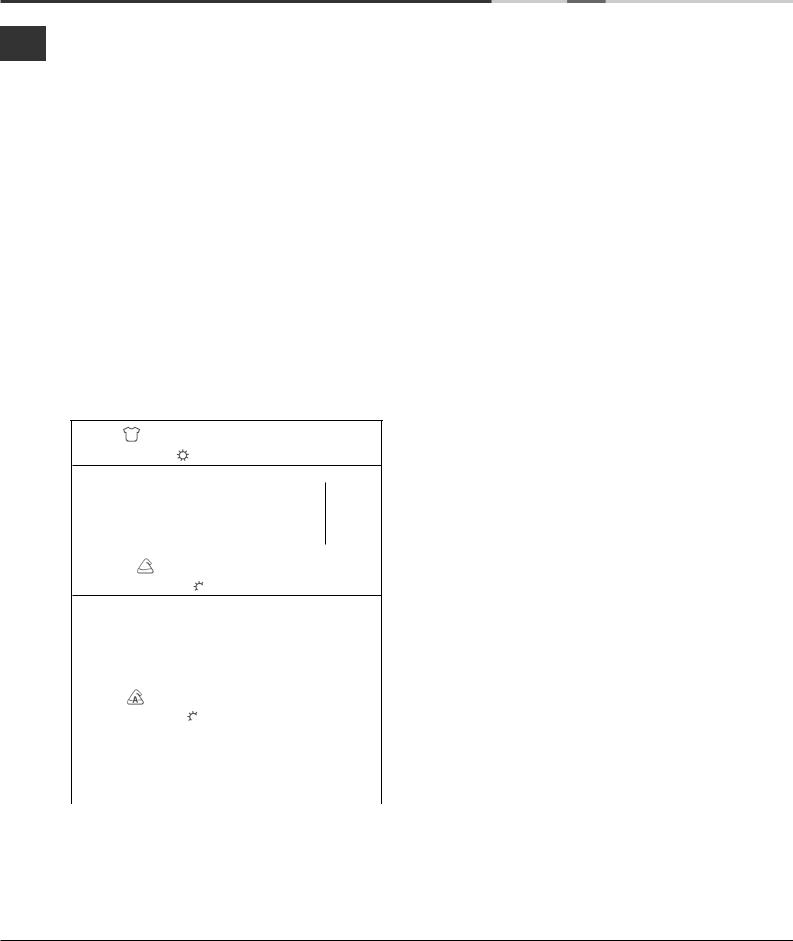
Bucato
Tessuti particolari
I
Coperte e copriletti: tessuti in acrilico (Acilan, Courtelle, Orion, Dralon) devono essere asciugati con estrema cura a temperatura BASSA. Non impostare mai tempi di asciugatura lunghi.
Indumenti con pieghe o plissettati: leggere le istruzioni di asciugatura fornite dal produttore.
Capi inamidati: non mischiare questi capi con altri capi non inamidati. Rimuovere la maggiore quantità possibile della soluzione iniziale prima di inserire i capi nell’asciugatrice. Non asciugare questi capi per troppo tempo: l’amido diverrebbe polvere lasciando gli abiti troppo morbidi e venendo meno la sua stessa funzione.
Tempi di asciugatura
La tabella riportata di seguito indica i tempi APPROSSIMATIVI di asciugatura espressi in minuti. I valori si riferiscono ad indumenti asciutti:
Cotone
Alta temperatura
Tempi di asciugatura dopo lavaggi in lavatrici da 800-1.000 giri al minuto
|
|
Mezzo carico |
|
|
|
Pieno carico |
|
|
|
|
|
|
|
1kg |
2kg |
3kg |
4kg |
5kg |
6kg |
7kg |
|
|
|
|
|
|
|
30-40 |
40-55 |
55-70 |
70-80 |
80-90 |
95-120120-140 |
|
|
|
|
|
|
|
|
Sintetici
Bassa temperatura
Tempi di asciugatura dopo lavaggi in lavatrici a velocità inferiori
|
|
Mezzo carico |
Pieno carico |
|
|
|
|
1kg |
|
2kg |
3kg |
|
|
|
|
40-50 |
|
50-70 |
70-90 |
|
|
|
|
Acrilico |
|
|
|
Bassa temperatura |
|
|
|
|
|
|
|
Tempi di asciugatura dopo lavaggi in lavatrici a velocità inferiori
|
Mezzo carico |
Pieno carico |
|
|
|
|
1kg |
2kg |
|
|
|
40-60 |
55-75 |
|
|
|
|
I tempi sono approssimativi e possono variare in base a:
•Quantità di acqua trattenuta dai capi dopo la centrifuga: le asciugamani e in genere i capi delicati trattengono molta acqua.
•Tessuto: i capi dello stesso tessuto, ma con trama e spessore differente, avranno sicuramente tempi di asciugatura diversi.
•Quantità di bucato: capi singoli e piccoli carichi, impiegano più tempo ad asciugarsi.
•Asciugatura: se i capi devono essere stirati, è consigliabile estrarli dall’asciugatrice quando sono ancora umidi. I capi che devono essere completamente asciutti, possono invece essere lasciati più a lungo.
•Temperatura impostata.
•Temperatura della stanza: più è bassa la temperatura della stanza in cui si trova l’asciugatrice, più tempo sarà necessario per l’asciugatura degli indumenti.
•Volume: alcuni capi voluminosi richiedono particolare cura nel processo di asciugatura. È consigliabile rimuovere questi capi, scuoterli e inserirli nuovamente nell’asciugatrice: questa operazione deve essere ripetuta diverse volte durante il ciclo di asciugatura.
! Non asciugare troppo gli indumenti. L’umidità naturale contenuta nei tessuti serve a conservarne la morbidezza e la vaporosità.
16
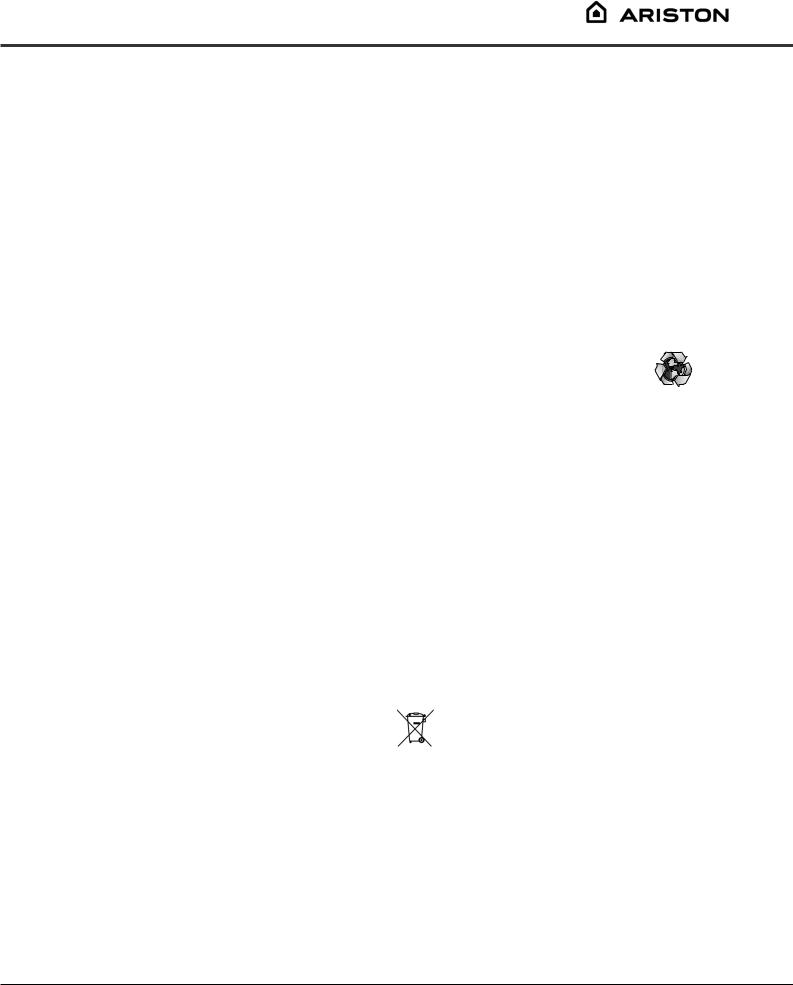
Avvertenze e suggerimenti
! Questo elettrodomestico è stato progettato e realizzato rispettando gli standard di sicurezza internazionale. Le presenti avvertenze vengono fornite per ragioni di sicurezza ed è importante leggerle con attenzione.
L’elettrodomestico è conforme alle seguenti direttive CEE:
-72/23/CEE e 93/68/CEE sui dispositivi a bassa tensione -89/336/CEE, 92/31/CEE e 93/68/CEE sulla compatibilità elettromagnetica
Sicurezza
•Questa asciugatrice è stata progettata per uso domestico e non professionale.
•L’asciugatrice deve essere utilizzata da persone adulte, che dovranno rispettare scrupolosamente le indicazioni fornite dal presente libretto di istruzioni.
•Non toccare l’elettrodomestico quando si è a piedi nudi né con le mani o i piedi bagnati.
•Per scollegare l’elettrodomestico dalla rete di alimentazione,bisogna tirare la spina: mai il cavo.
•Non lasciare avvicinare i bambini all’elettrodomestico in funzione. Dopo l’uso, spegnere l’asciugatrice e scollegarla dalla rete di alimentazione. Tenere lo sportello chiuso, per evitare che i bambini possano utilizzare l’asciugatrice come un gioco.
•L’elettrodomestico deve essere installato correttamente e deve avere un’adeguata aerazione.
Èimportante non ostruire mai la presa d’aria sulla parte frontale dell’asciugatrice e lo sfiato sul retro (vedere la sezione Installazione).
•Non utilizzare l’asciugatrice sulla moquette, nel caso in cui l’altezza del pelo sia tale da impedire l’ingresso dell’aria attraverso la base dell’asciugatrice.
•Verificare che l’asciugatrice sia vuota prima di iniziare a caricarla.
•La parte posteriore dell’asciugatrice può
diventare molto calda. Evitare assolutamente di toccarla durante il funzionamento dell’elettrodomestico.
•Non utilizzare l’asciugatrice se il filtro, il recipiente di raccolta dell’acqua ed il condensatore non sono posizionati correttamente (vedere la sezione Manutenzione).
•Non utilizzare ammorbidente liquido per i tessuti nell’asciugatrice; aggiungerlo all’ultimo risciacquo del ciclo di lavaggio.
•Non sovraccaricare l’asciugatrice (vedere la sezione Bucato per i vari limiti di carico).
•Non inserire capi completamente bagnati.
•Prima di essere caricati nell’asciugatrice, i capi devono essere lavati con acqua e sapone, risciacquati e infine centrifugati. L’asciugatura di capi che NON siano stati precedentemente lavati con acqua, determina il pericolo di incendio.
•Seguire sempre con attenzione tutte le istruzioni riportate sulle etichette per il lavaggio dei capi (vedere la sezione Bucato).
•Non caricare nell’asciugatrice capi precedentemente trattati con prodotti chimici.
•Non introdurre mai indumenti che siano venuti a contatto con sostanze infiammabili (petrolio, olio, vernice, lacca, creme, oli o grassi da cucina).
•Non introdurre nell’asciugatrice gomma, gommapiuma, plastica, plastica espansa, pannolini o fodere per pannolini, polietilene o carta
•Non introdurre nell’asciugatrice capi troppo voluminosi.
•Non asciugare fibre acriliche ad alte temperature.
•Completare ogni programma con la relativa fase di Asciugatura a freddo.
•Non spegnere l’asciugatrice se vi sono ancora capi caldi all’interno.
•Pulizia del filtro dopo ogni utilizzo (vedere la sezione Manutenzione).
•Svuotare il recipiente di raccolta dell’acqua dopo ogni utilizzo (vedere la sezione Manutenzione).
•Pulire regolarmente l’unità di condensazione (vedere la sezione Manutenzione).
•Evitare l’accumulo di laniccio intorno all’asciugatrice.
•Non salire sul pannello superiore dell’elettrodomestico, perché in questo modo si potrebbe danneggiare gravemente l’asciugatrice.
•Rispettare sempre gli standard e le caratteristiche elettriche (vedere la sezione Installazione).
•Acquistare solo accessori e parti di ricambio
originali (vedere la sezione Assistenza).
Smaltimento e Riciclaggio
Come parte del nostro costante impegno in difesa dell’ambiente, ci riserviamo il diritto di utilizzare componenti riciclati per diminuire i costi del cliente e ridurre lo spreco di materiali.
•Smaltimento del materiale di imballaggio: seguire le normative locali in tema di smaltimento, così da permettere di riciclare l’imballaggio.
•Per ridurre i rischi di incidenti ai bambini, rimuovere la porta e la spina, quindi tagliare il cavo di alimentazione a filo con l’apparecchio. Smaltire queste parti separatamente, per assicurarsi che l’apparecchio non possa più essere collegato ad una presa di corrente.
Dismissione degli elettrodomestici
La direttiva Europea 2002/96/CE sui rifiuti di apparecchiature elettriche ed elettroniche (RAEE), prevede che gli elettrodomestici non debbano essere smaltiti nel normale flusso dei rifiuti solidi urbani. Gli apparecchi dismessi devono essere raccolti separatamente per ottimizzare il tasso di recupero e riciclaggio dei materiali che li compongono ed impedire potenziali danni per la salute e l’ambiente.
Il simbolo del cestino barrato è riportato su tutti i prodotti per ricordare gli obblighi di raccolta separata.
Per ulteriori informazioni, sulla corretta dismissione degli elettrodomestici, i detentori potranno rivolgersi al servizio pubblico preposto o ai rivenditori.
Risparmio energetico e rispetto dell’ambiente
•Strizzare bene i capi per rimuovere tutta l’acqua possibile prima di introdurli nell’asciugatrice (se si utilizza una lavatrice, impostare un ciclo di centrifuga). In questo modo si risparmieranno tempo ed energia durante l’asciugatura.
•Ogni volta che si utilizza l’asciugatrice a pieno carico, si risparmia energia: capi singoli e piccoli carichi, impiegano più tempo ad asciugarsi.
•Pulire il filtro alla fine di ogni ciclo di asciugatura così da contenere i costi connessi al consumo energetico (vedere la sezione Manutenzione).
|
I |
|
|
Installazione |
|
|
|
Descrizione |
|
|
|
programmi |
Avvioe |
|
|
Bucato |
|
|
|
suggerimenti |
Avvertenzee |
|
|
manutenzione |
Curae |
|
|
Ricercaguasti |
|
|
|
Assistenza |
|
|
|
17

Cura e manutenzione
I |
Scollegamento dell’apparecchio dalla |
Controllo del cestello al termine di ogni |
|
rete elettrica |
ciclo |
||
|
|||
|
! L’asciugatrice deve essere sempre scollegata |
Ruotare il cestello manualmente per rimuovere i |
|
|
quando non è in funzione, durante le operazioni di |
piccoli capi (fazzoletti) che potrebbero essere rimasti |
|
|
pulizia e durante qualsiasi operazione di |
all’interno dell’asciugatrice. |
|
|
manutenzione. |
|
Pulizia del filtro dopo ogni ciclo
Il filtro è un componente fondamentale dell’asciugatrice: la sua funzione è quella di raccogliere il laniccio e i nugoli che si formano durante l’asciugatura.Al termine di ogni ciclo di asciugatura, è quindi importante pulire a fondo il filtro, sciacquandolo sotto l’acqua corrente o pulendolo con l’aspirapolvere. Se il filtro si intasa, il flusso dell’aria all’interno sarà gravemente compromesso: I tempi di asciugatura si allungheranno e così si consumerà molta più energia. Potrebbero anche verificarsi danni all’asciugatrice.
Il filtro si trova vicino alla guarnizione (vedere a figura).
Rimozione del filtro:
1.Tirare verso l’alto il manico in plastica del filtro (vedere a figura).
2.Pulire il filtro e riposizionarlo correttamente. Assicurarsi che il filtro sia inserito fino in fondo nel relativo alloggiamento dell’asciugatrice.
! Non utilizzare l’asciugatrice se il filtro non è stato riposizionato.
Svuotare il recipiente di raccolta dell’acqua dopo ogni ciclo
Estrarre il recipiente dall’asciugatrice e svuotarlo in un lavandino o in un altro scarico adatto, quindi riposizionarlo correttamente.
Recipiente di raccolta |
|
|
Filtro |
|
|||
dell’acqua |
|
|
|
|
|
|
|
|
|
|
|
Coperchio del
condensatore Presa
d’aria
Fermi Maniglia
Pulizia dell’unità di condensazione
Rimuovere periodicamente (ogni mese) l’unità di condensazione e rimuovere l’eventuale lanugine formatasi tra le piastre sciacquandola sotto il rubinetto con acqua fredda, sul lato posteriore del condensatore.
Come rimuovere il condensatore:
1.Scollegare l’asciugatrice dalla rete elettrica e aprire lo sportello.
2.Aprire il coperchio del condensatore (vedere schema). Sbloccare i tre fermi ruotandoli a 90° in senso antiorario, quindi estrarre il condensatore dall’asciugatrice agendo sull’impugnatura.
3.Pulire la superficie delle guarnizioni di tenuta e riposizionare l’unità accertandosi che i fermi siano stati bloccati.
Pulizia
•Le parti esterne in metallo e plastica e le parti in gomma possono essere pulite con un panno
umido.
●Periodicamente (ogni 6 mesi) aspirare la griglia della presa d’aria frontale e gli sfiati sul retro dell’asciugatrice per rimuovere ogni eventuale formazione di lanugine, fili o polvere. Inoltre per rimuovere accumuli di lanugine dalla parte frontale del condensatore e dalle aree dei filtri, pulire di tanto in tanto con un’aspirapolvere.
!Non usare solventi o abrasivi.
!L’asciugatrice utilizza dei componenti a sfera che non necessitano di lubrificazione.
!Far controllare regolarmente l’asciugatrice da personale tecnico qualificato per la sicurezza delle parti elettriche e meccaniche (vedere la sezione
 Rubinetto
Rubinetto
Posteriore
Anteriore
Unità di condensazione
18

Ricerca guasti
Potrebbe accadere che l’asciugatrice sembri fuori uso. Prima di contattare il centro di assistenza (vedere la sezione Assistenza), analizzare i seguenti suggerimenti per la risoluzione dei problemi:
Problema: |
Possibili cause / Soluzioni: |
L’asciugatrice non si accende. |
• La spina potrebbe non essere inserita oppure potrebbe non riuscire a |
|
fare contatto. |
|
• Potrebbe essersi verificata una mancanza di corrente. |
|
• Il fusibile potrebbe esseri bruciato. Provare a collegare un altro |
|
elettrodomestico alla stessa presa. |
|
• Se si utilizza una prolunga, provare a inserire la spina dell’asciugatrice |
|
direttamente nella presa. |
|
• Lo sportello potrebbe non essere chiuso correttamente. |
|
• La manopola TIMER potrebbe non essere stata impostata correttamente |
|
(vedere la sezione Avvio e programmi). |
|
• Potrebbe non essere stato premuto il pulsante START (vedere la sezione |
|
Avvio e programmi). |
L’asciugatura impiega troppo |
• Il filtro potrebbe non essere stato pulito correttamente (vedere la sezione |
tempo. |
Manutenzione). |
|
• La temperatura impostata potrebbe non essere adatta al tipo di |
|
tessuto da asciugare (vedere la sezione Avvio e programmi, e la sezione |
|
Bucato). |
|
• Potrebbe essere necessario svuotare il recipiente di raccolta dell’acqua? |
|
Controllare se spia luminosa svuota acqua è acceso? (vedere la sezione |
|
Manutenzione). |
|
• Il condensatore ha bisogno di essere pulito? (vedere la sezione |
|
Manutenzione). |
|
• Potrebbe non essere stato selezionato il tempo di asciugatura corretto |
|
per il tipo di carico (vedere la sezione Bucato). |
|
• La griglia della presa d’aria o gli sfiati sul retro potrebbero essere ostruiti |
|
(vedere la sezione Installazione, e la sezione Manutenzione). |
|
• Gli indumenti erano forse troppo bagnati (vedere la sezione Bucato). |
|
• L’asciugatrice potrebbe essere sovraccarica (vedere la sezione Bucato). |
|
I |
|
|
Installazione |
|
|
|
Descrizione |
|
|
|
programmi |
e Avvio |
|
|
Bucato |
|
|
|
suggerimenti |
e Avvertenze |
|
|
manutenzione |
e Cura |
|
|
guasti Ricerca |
|
|
|
Assistenza |
|
|
|
19

Assistenza
I |
Prima di chiamare il centro di |
|
assistenza: |
||
|
||
|
• Provare a risolvere il problema in modo autonomo |
|
|
servendosi dei consigli della sezione Risoluzione |
|
|
dei problemi. |
|
|
• In caso contrario, spegnere l’asciugatrice e |
|
|
chiamare il più vicino centro di assistenza. |
Notizie da comunicare al centro di assistenza:
•nome, indirizzo e codice postale
•numero di telefono
•tipo di problema verificatosi
•data di acquisto
•modello dell’apparecchio (Mod.)
•numero di serie (S/N)
Queste informazioni sono riportate sull’etichetta dei dati posta all’interno dello sportello dell’asciugatrice.
Assistenza
Ricambi
L’asciugatrice è un elettrodomestico complesso: tentare di ripararlo da soli o farlo riparare da persone non qualificate, oltre a poter provocare lesioni, potrebbe anche danneggiare in modo grave l’apparecchio e invalidare la garanzia sulle parti di ricambio. Contattare sempre un tecnico qualificato nel caso in cui si verifichi un malfunzionamento dell’asciugatrice. Ogni ricambio è stato progettato specificamente per quest’asciugatrice.
20

Notice d’utilisation et installation
SÈCHE-LINGE
GB |
|
I |
|
F |
|
|
|
|
|
|
|
English, 1 |
Italiano, 11 |
Français, 21 |
|||
|
|
|
|||
D |
|
E |
|
P |
|
|
|
|
|
|
|
Deutsch, 31 |
Español, 41 |
Português, 51 |
|||
Table des Matières |
F |
|
Installation, 22
Instructions d’inversion de la porte
Où installer votre sèche-linge
Ventilation
Vidange de l’eau
Connexions électrique
Avant de commencer à utiliser votre sèche-linge
NL
Nederlands, 61
AS70C
AS70CX
Description du sèche-linge, 23
Pour ouvrir la porte
Caractéristiques
Panneau de commandes
Démarrage et programmes, 24
Choisir un programme
Linge, 25-26
Trier votre linge Étiquettes d’entretien Vêtements spéciaux Temps de séchage
Avertissements et Suggestions, 27
Sécurité générale Élimination
Économiser de l’énergie et respecter l’environnement
Entretien et Nettoyage, 28
Éteindre l’électricité
Nettoyer le filtre après chaque cycle
Videz le réservoir d’eau aprè chaque cycle Vérifier le tambour après chaque cycle Nettoyage du groupe condenseur Nettoyer le sèche-linge
Que faire en cas de panne, 29
Service Après-vente, 30
Pièces de rechange
21
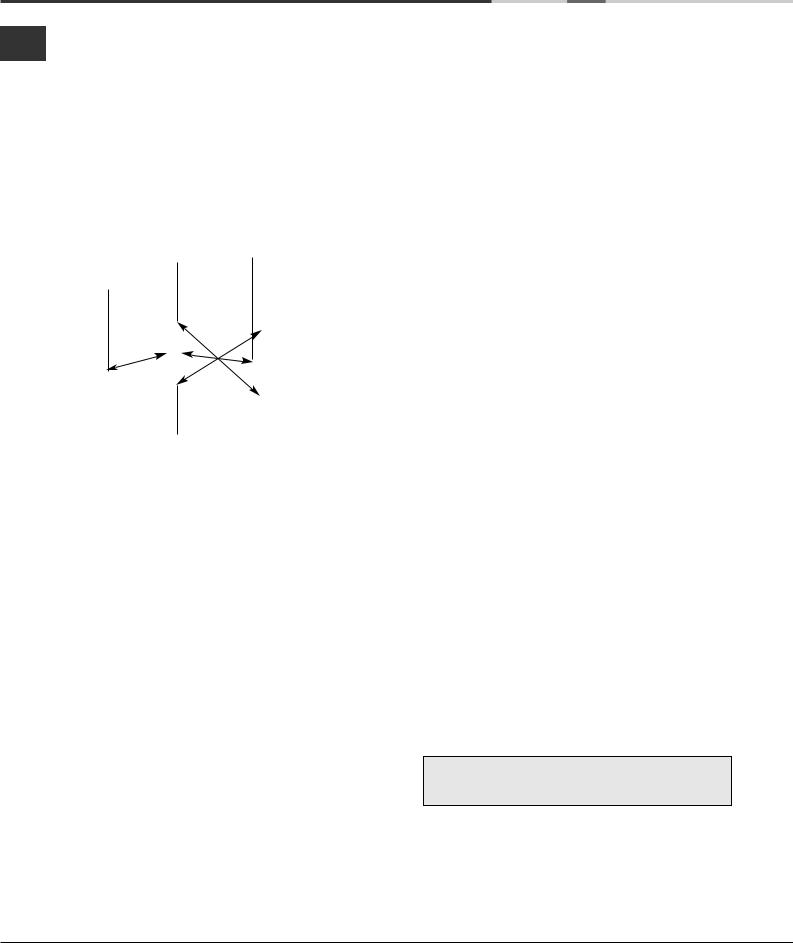
Installation
F
! Conservez cette notice d’utilisation et d’installation à portée de main de manière à pouvoir vous y référer si nécessaire. Emmenez-la avec vous si vous déménagez, et, si vous vendez cet appareil ou que vous le donniez à un tiers, faites en sorte que cette notice accompagne le sèche-linge de manière à ce que le nouveau propriétaire soit informé des avertissements et suggestions concernant le fonctionnement de ce sèche-linge.
! Lisez attentivement ce mode d’emploi; les pages suivantes contiennent des informations importantes concernant l’installation et des suggestions relatives au fonctionnement de cet appareil.
Instructions d’inversion de la porte
Loquet de la porte
Charnière
Taquet de la porte
Charnière
La porte de votre sèche-linge est réversible et les charnières peuvent être facilement changées de côté. Echangez diagonalement les supports de charnières et les vis d’obturation. Echangez le taquet de la porte et le loquet avec leur plaque d’obturation opposée (voir schéma ci-dessus)
Où installer votre sèche-linge
●Placez votre sèche-linge à une certaine distance des cuisinières, fourneaux, radiateurs, ou plaques de cuisson à gaz, car les flammes peuvent endommager cet appareil.
●Si vous installez cet appareil sous un plan de travail, faites en sorte de laisser un espace de 10 mm entre le dessus de l’appareil et tout autre objet sur ou au-dessus de la machine, et un espace de 15 mm entre les côtés et les éléments d’ameublement ou les murs latéraux. Ceci a pour objectif d’assurer une ventilation convenable. Assurez-vous que les orifices de ventilation situés à l’arrière ne soient pas obstrués.
Ventilation
Lorsque le sèche-linge est en marche, une aération adéquate est nécessaire. Faites en sorte d’installer votre sèche-linge dans un environnement qui n’est pas humide et qui est doté d’une bonne circulation d’air dans toute la pièce. La circulation d’air autour du sèche linge est essentielle pour condenser l’eau produite au cours du lavage, le sèche linge ne fonctionnera pas efficacement dans un espace clos ou dans un placard.
! Si l’on utilise le sèche linge dans une pièce froide ou petite, on rencontrera un certain degré de condensation.
Vidange de l’eau
Si votre sèche-linge est installé à proximité d’une évacuation, l’eau peut être vidangée dans ce tuyau. Cela évite de vider le réservoir d’eau. Il suffit de retirer le tuyau flexible supérieur de son raccord supérieur à l’arrière du sèche-linge et de raccorder le tuyau fourni au tuyau d’évacuation.
Connexions électriques
Assurez-vous des points suivants avant de brancher la fiche de l’appareil dans la prise de courant:
●La prise de courant doit être reliée à la terre.
●La prise de courant doit pouvoir supporter la puissance maximale de la machine, qui est indiquée sur la plaque signalétique de l’appareil (voir la Description du Sèche-linge).
●La tension électrique doit appartenir à la gamme de valeurs indiquée sur la plaque signalétique de l’appareil (voir la Description du Sèche-linge).
●La prise de courant doit être compatible avec la fiche du sèche-linge. Si ce n’est pas le cas, remplacez la fiche ou la prise de courant.
!Le sèche-linge ne doit pas être utilisé à l’extérieur, même si l’espace en question est abrité. Cela peut être dangereux si l’appareil est exposé à la pluie ou à des orages.
!Une fois installés, le cordon d’alimentation et la fiche du sèche-linge doivent être d’accès facile.
!N’utilisez pas de rallonges.
!Le cordon d’alimentation ne doit pas être courbé ou écrasé.
!Le cordon d’alimentation électrique doit être vérifié périodiquement et remplacé par un cordon préparé spécialement pour ce sèche-linge, et installé uniquement par des électriciens agréés (voir Service Après-vente). Des cordons d’alimentation neufs ou plus longs sont fournis par les revendeurs agréés contre un supplément.
!Le fabricant rejète toute responsabilité en cas de non-respect de toutes ou partie de ces règles.
!En cas de doute au sujet des points precedents, consultez un electricien qualfie.
Avant de commencer à utiliser votre sèche-linge
Une fois que vous avez installé votre sèche-linge, et avant de l’utiliser, nettoyez l’intérieur du tambour pour retirer les poussières qui pourraient s’y être accumulées durant le transport.
22
